air conditioning MITSUBISHI ENDEAVOR 2004 Service Repair Manual
[x] Cancel search | Manufacturer: MITSUBISHI, Model Year: 2004, Model line: ENDEAVOR, Model: MITSUBISHI ENDEAVOR 2004Pages: 3870, PDF Size: 98.47 MB
Page 1498 of 3870
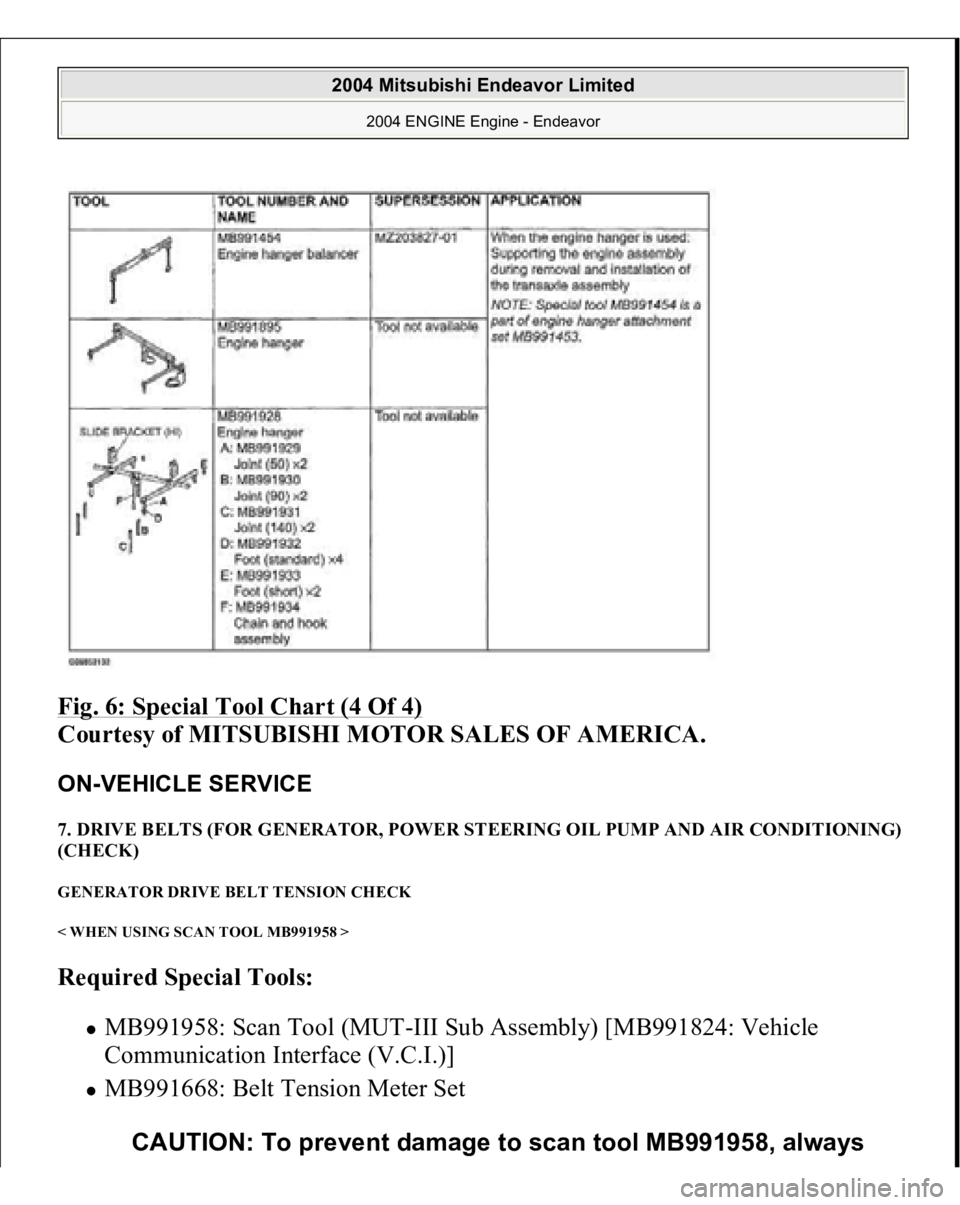
Fig. 6: Special Tool Chart (4 Of 4)
Courtesy of MITSUBISHI MOTOR SALES OF AMERICA.
ON-VEHICLE SERVICE 7. DRIVE BELTS (FOR GENERATOR, POWER STEERING OIL PUMP AND AIR CONDITIONING)
(CHECK) GENERATOR DRIVE BELT TENSION CHECK < WHEN USING SCAN TOOL MB991958 > Required Special Tools:
MB991958: Scan Tool (MUT-III Sub Assembly) [MB991824: Vehicle
Communication Interface (V.C.I.)] MB991668: Belt Tension Meter Set
CAUTION: To prevent damage to scan tool MB991958, always
2004 Mitsubishi Endeavor Limited
2004 ENGINE Engine - Endeavor
Page 1997 of 3870
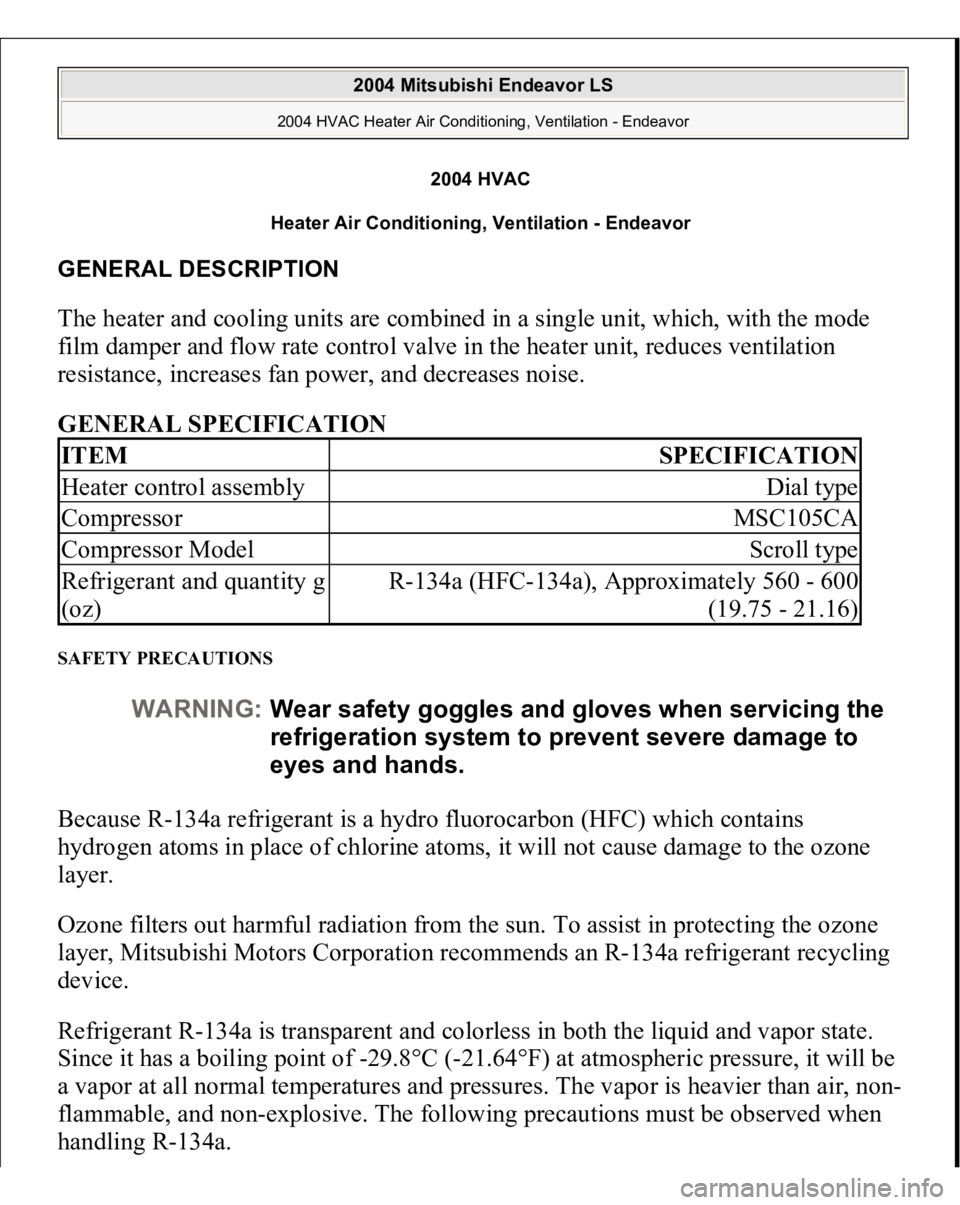
2004 HVAC
Heater Air Conditioning, Ventilation - Endeavor
GENERAL DESCRIPTION The heater and cooling units are combined in a single unit, which, with the mode
film damper and flow rate control valve in the heater unit, reduces ventilation
resistance, increases fan power, and decreases noise.
GENERAL SPECIFICATION SAFETY PRECAUTIONS Because R-134a refrigerant is a hydro fluorocarbon (HFC) which contains
hydrogen atoms in place of chlorine atoms, it will not cause damage to the ozone
layer.
Ozone filters out harmful radiation from the sun. To assist in protecting the ozone
layer, Mitsubishi Motors Corporation recommends an R-134a refrigerant recycling
device.
Refrigerant R-134a is transparent and colorless in both the liquid and vapor state.
Since it has a boiling point of -29.8°C (-21.64°F) at atmospheric pressure, it will be
a vapor at all normal temperatures and pressures. The vapor is heavier than air, non-
flammable, and non-explosive. The following precautions must be observed when
handlin
g R-134a.
ITEM
SPECIFICATION
Heater control assembly
Dial type
Compressor
MSC105CA
Compressor Model
Scroll type
Refrigerant and quantity g
(oz)
R-134a (HFC-134a), Approximately 560 - 600
(19.75 - 21.16)
WARNING:Wear safety goggles and gloves when servicing the
refrigeration system to prevent severe damage to
eyes and hands.
2004 Mitsubishi Endeavor LS
2004 HVAC Heater Air Conditioning, Ventilation - Endeavor
2004 Mitsubishi Endeavor LS
2004 HVAC Heater Air Conditioning, Ventilation - Endeavor
Page 1998 of 3870
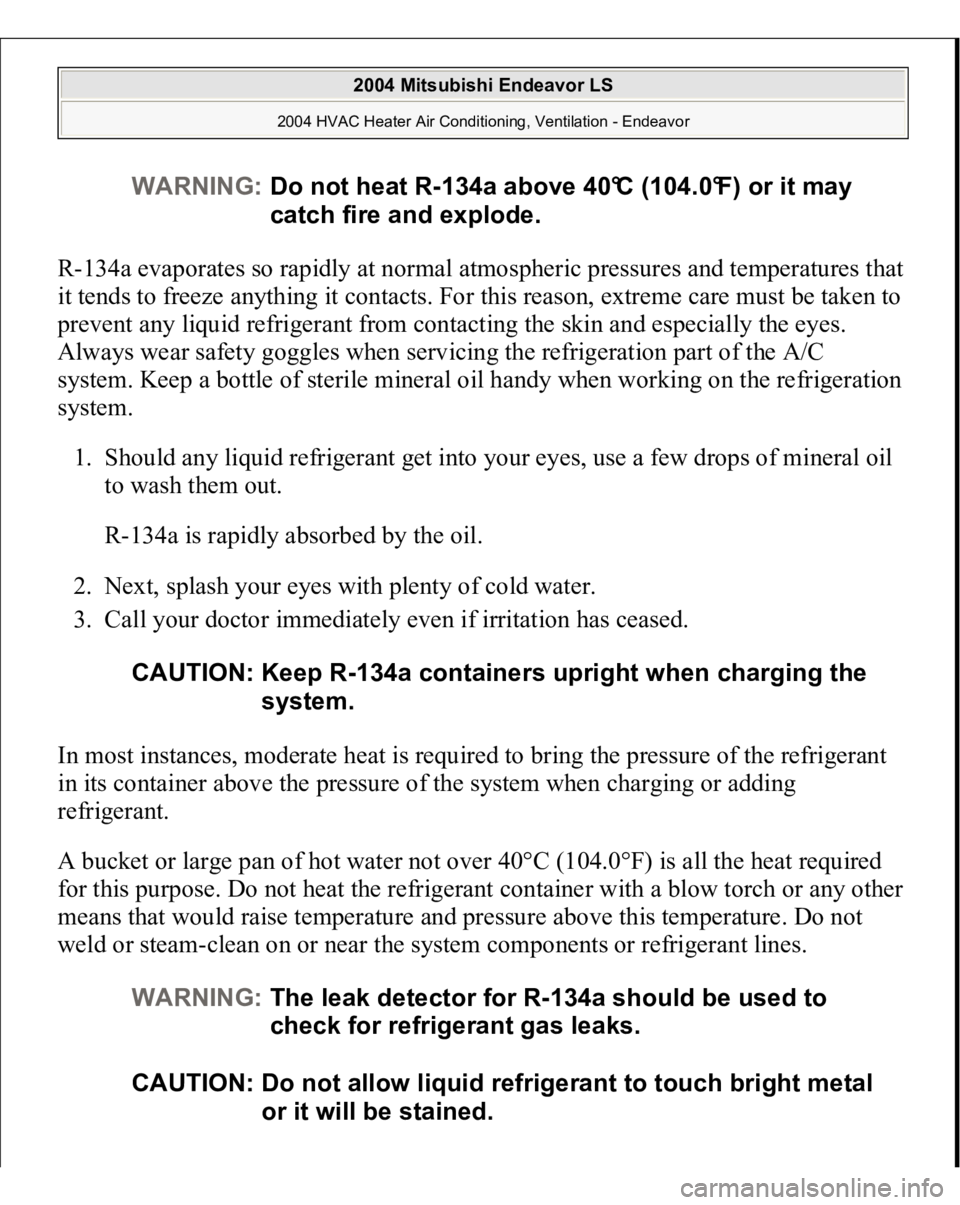
R-134a evaporates so rapidly at normal atmospheric pressures and temperatures that
it tends to freeze anything it contacts. For this reason, extreme care must be taken to
prevent any liquid refrigerant from contacting the skin and especially the eyes.
Always wear safety goggles when servicing the refrigeration part of the A/C
system. Keep a bottle of sterile mineral oil handy when working on the refrigeration
system.
1. Should any liquid refrigerant get into your eyes, use a few drops of mineral oil
to wash them out.
R-134a is rapidly absorbed by the oil.
2. Next, splash your eyes with plenty of cold water.
3. Call your doctor immediately even if irritation has ceased.
In most instances, moderate heat is required to bring the pressure of the refrigerant
in its container above the pressure of the system when charging or adding
refrigerant.
A bucket or large pan of hot water not over 40°C (104.0°F) is all the heat required
for this purpose. Do not heat the refrigerant container with a blow torch or any other
means that would raise temperature and pressure above this temperature. Do not
weld or steam-clean on or near the system components or refrigerant lines.
WARNING:Do not heat R-134a above 40°C (104.0°F) or it may
catch fire and explode.
CAUTION: Keep R-134a containers upright when charging the
system.
WARNING:The leak detector for R-134a should be used to
check for refrigerant gas leaks.
CAUTION: Do not allow liquid refrigerant to touch bright metal
or it will be stained.
2004 Mitsubishi Endeavor LS
2004 HVAC Heater Air Conditioning, Ventilation - Endeavor
Page 1999 of 3870
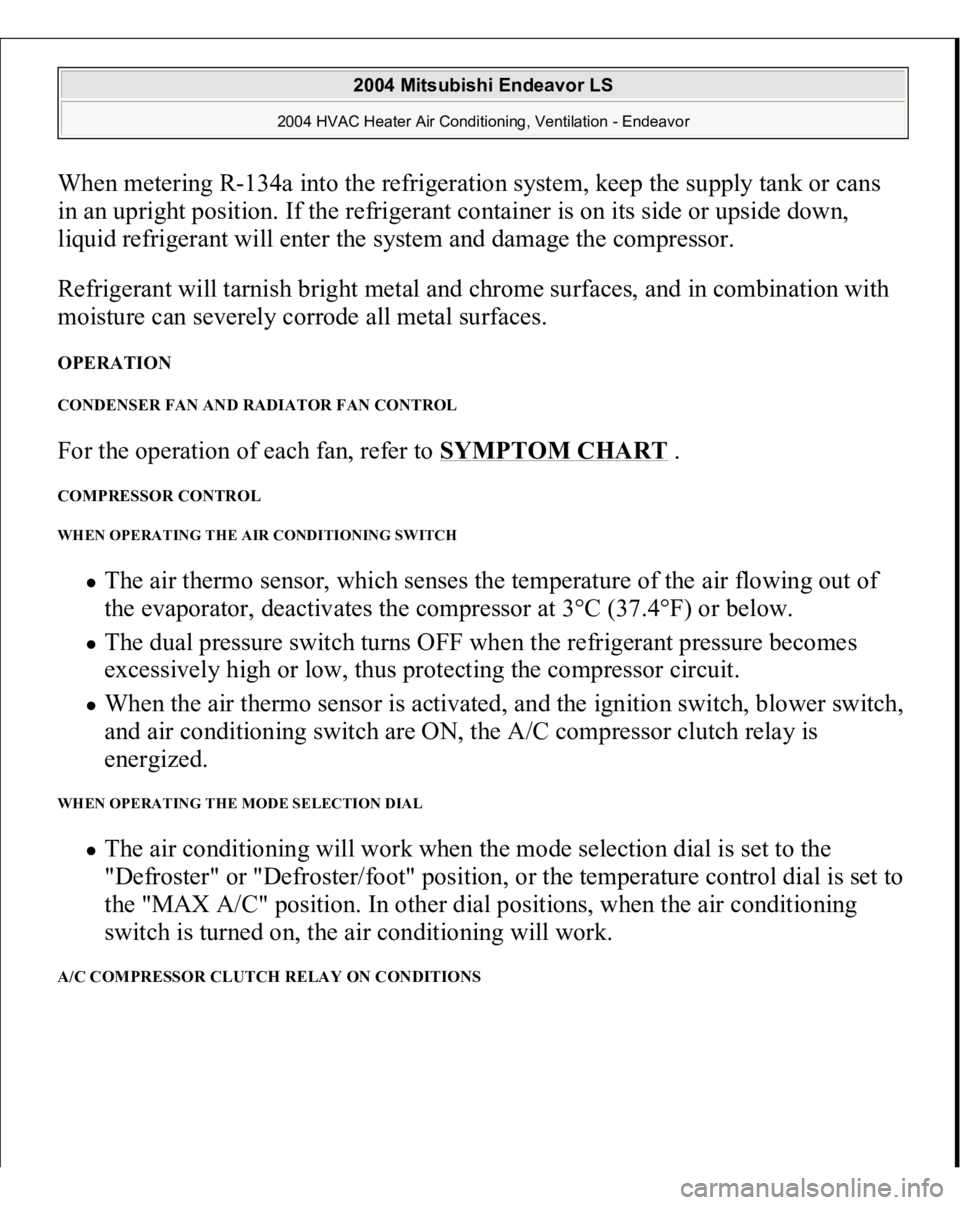
When metering R-134a into the refrigeration system, keep the supply tank or cans
in an upright position. If the refrigerant container is on its side or upside down,
liquid refrigerant will enter the system and damage the compressor.
Refrigerant will tarnish bright metal and chrome surfaces, and in combination with
moisture can severely corrode all metal surfaces. OPERATION CONDENSER FAN AND RADIATOR FAN CONTROL For the operation of each fan, refer to
SYMPTOM CHART
.
COMPRESSOR CONTROL WHEN OPERATING THE AIR CONDITIONING SWITCH
The air thermo sensor, which senses the temperature of the air flowing out of
the evaporator, deactivates the compressor at 3°C (37.4°F) or below. The dual pressure switch turns OFF when the refrigerant pressure becomes
excessively high or low, thus protecting the compressor circuit. When the air thermo sensor is activated, and the ignition switch, blower switch,
and air conditioning switch are ON, the A/C compressor clutch relay is
energized.
WHEN OPERATING THE MODE SELECTION DIAL
The air conditioning will work when the mode selection dial is set to the
"Defroster" or "Defroster/foot" position, or the temperature control dial is set to
the "MAX A/C" position. In other dial positions, when the air conditioning
switch is turned on, the air conditioning will work.
A/C COMPRESSOR CLUTCH RELAY ON CONDITIONS
2004 Mitsubishi Endeavor LS
2004 HVAC Heater Air Conditioning, Ventilation - Endeavor
Page 2000 of 3870
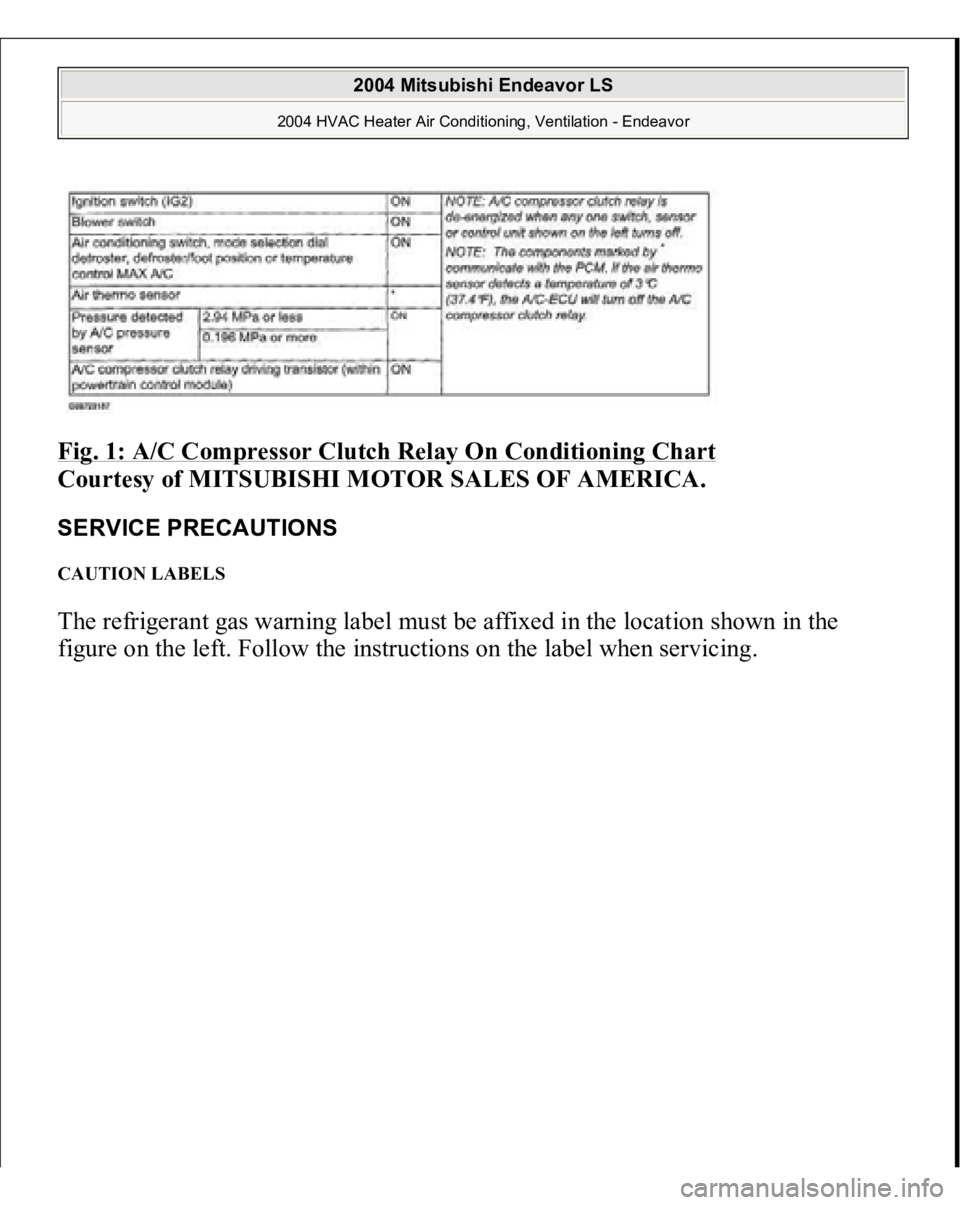
Fig. 1: A/C Compressor Clutch Relay On Conditioning Chart
Courtesy of MITSUBISHI MOTOR SALES OF AMERICA.
SERVICE PRECAUTIONS CAUTION LABELS The refrigerant gas warning label must be affixed in the location shown in the
figure on the left. Follow the instructions on the label when servicin
g.
2004 Mitsubishi Endeavor LS
2004 HVAC Heater Air Conditioning, Ventilation - Endeavor
Page 2001 of 3870
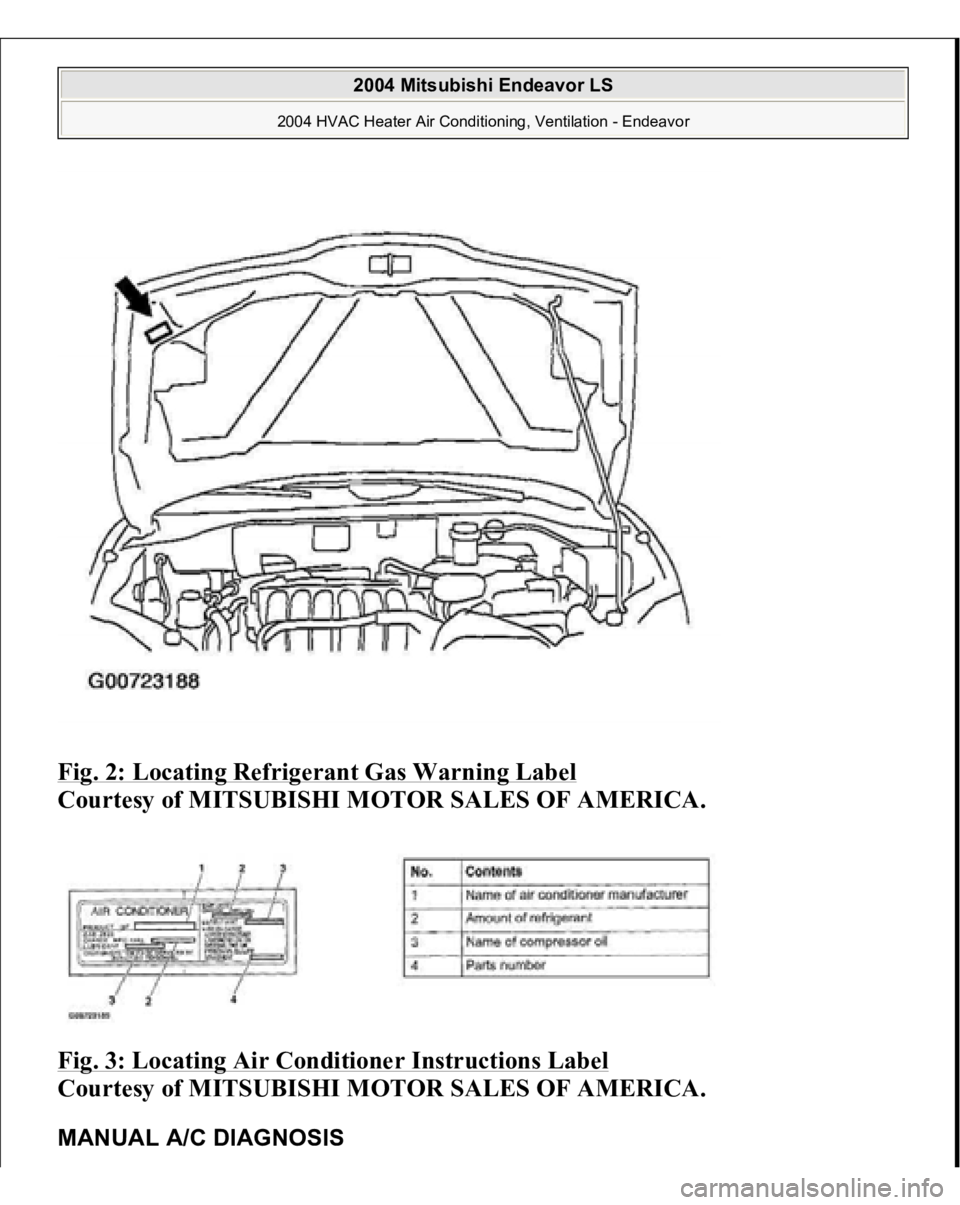
Fig. 2: Locating Refrigerant Gas Warning Label
Courtesy of MITSUBISHI MOTOR SALES OF AMERICA.
Fig. 3: Locating Air Conditioner Instructions Label
Courtesy of MITSUBISHI MOTOR SALES OF AMERICA.
MANUAL A/C DIAGNOSIS
2004 Mitsubishi Endeavor LS
2004 HVAC Heater Air Conditioning, Ventilation - Endeavor
Page 2002 of 3870
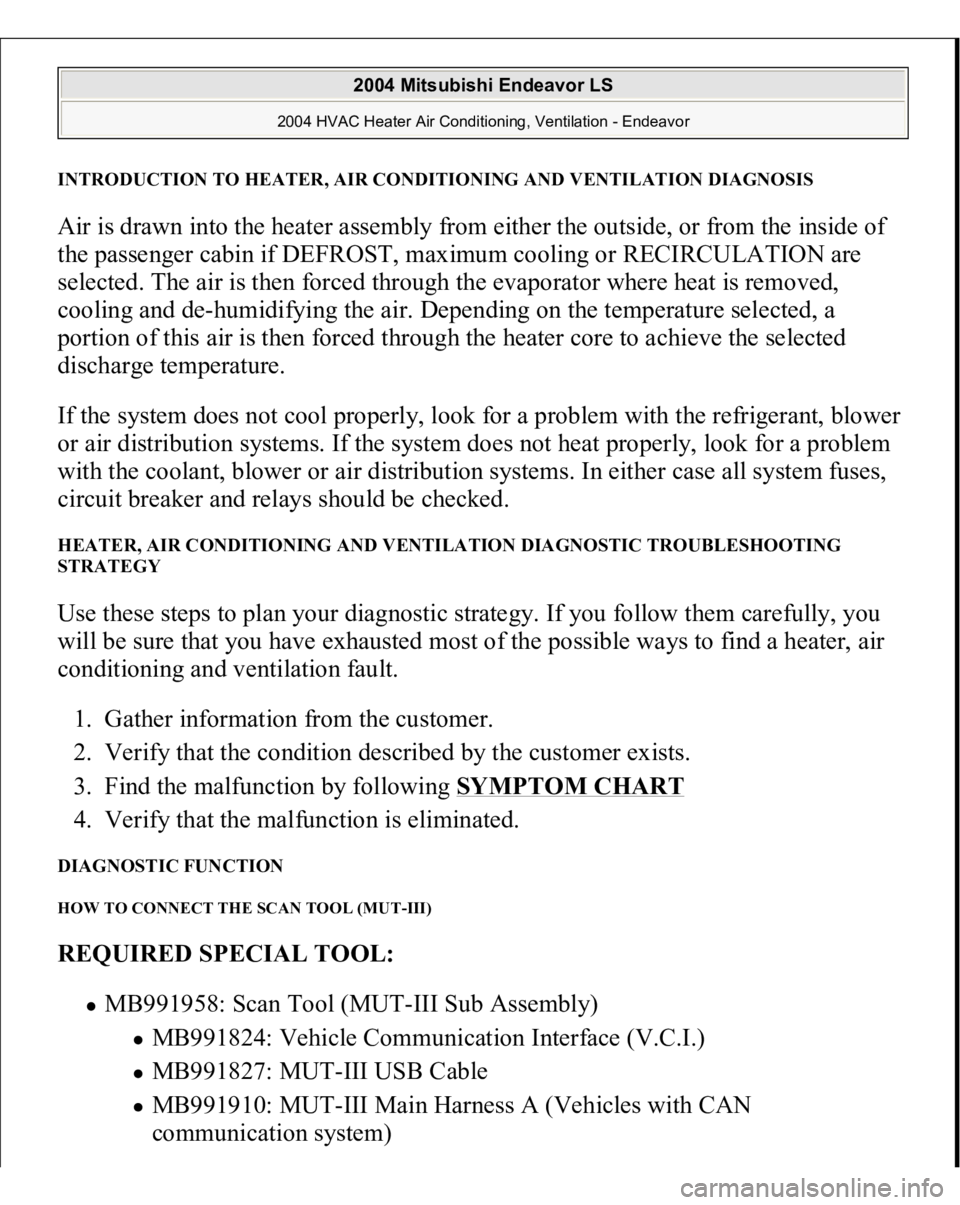
INTRODUCTION TO HEATER, AIR CONDITIONING AND VENTILATION DIAGNOSISAir is drawn into the heater assembly from either the outside, or from the inside of
the passenger cabin if DEFROST, maximum cooling or RECIRCULATION are
selected. The air is then forced through the evaporator where heat is removed,
cooling and de-humidifying the air. Depending on the temperature selected, a
portion of this air is then forced through the heater core to achieve the selected
discharge temperature.
If the system does not cool properly, look for a problem with the refrigerant, blower
or air distribution systems. If the system does not heat properly, look for a problem
with the coolant, blower or air distribution systems. In either case all system fuses,
circuit breaker and relays should be checked. HEATER, AIR CONDITIONING AND VENTILATION DIAGNOSTIC TROUBLESHOOTING
STRATEGY Use these steps to plan your diagnostic strategy. If you follow them carefully, you
will be sure that you have exhausted most of the possible ways to find a heater, air
conditioning and ventilation fault.
1. Gather information from the customer.
2. Verify that the condition described by the customer exists.
3. Find the malfunction by following
SYMPTOM CHART
4. Verify that the malfunction is eliminated.
DIAGNOSTIC FUNCTION HOW TO CONNECT THE SCAN TOOL (MUT-III) REQUIRED SPECIAL TOOL:
MB991958: Scan Tool (MUT-III Sub Assembly)
MB991824: Vehicle Communication Interface (V.C.I.) MB991827: MUT-III USB Cable MB991910: MUT-III Main Harness A (Vehicles with CAN
communication system)
2004 Mitsubishi Endeavor LS
2004 HVAC Heater Air Conditioning, Ventilation - Endeavor
Page 2003 of 3870
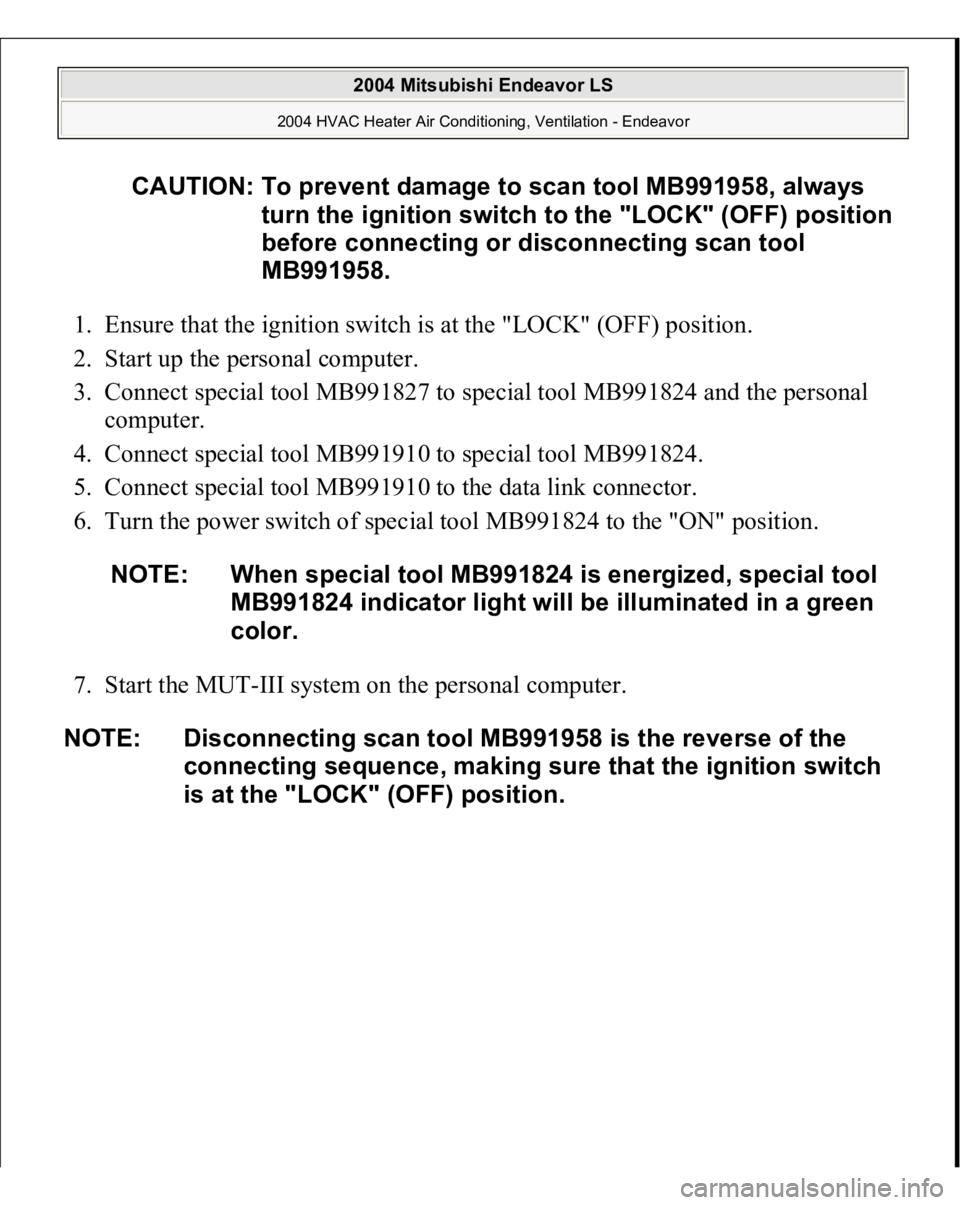
1. Ensure that the ignition switch is at the "LOCK" (OFF) position.
2. Start up the personal computer.
3. Connect special tool MB991827 to special tool MB991824 and the personal
computer.
4. Connect special tool MB991910 to special tool MB991824.
5. Connect special tool MB991910 to the data link connector.
6. Turn the power switch of special tool MB991824 to the "ON" position.
7. Start the MUT-III system on the personal computer.
CAUTION: To prevent damage to scan tool MB991958, always
turn the ignition switch to the "LOCK" (OFF) position
before connecting or disconnecting scan tool
MB991958.
NOTE: When special tool MB991824 is energized, special tool
MB991824 indicator light will be illuminated in a green
color.
NOTE: Disconnecting scan tool MB991958 is the reverse of the
connecting sequence, making sure that the ignition switch
is at the "LOCK" (OFF) position.
2004 Mitsubishi Endeavor LS
2004 HVAC Heater Air Conditioning, Ventilation - Endeavor
Page 2004 of 3870
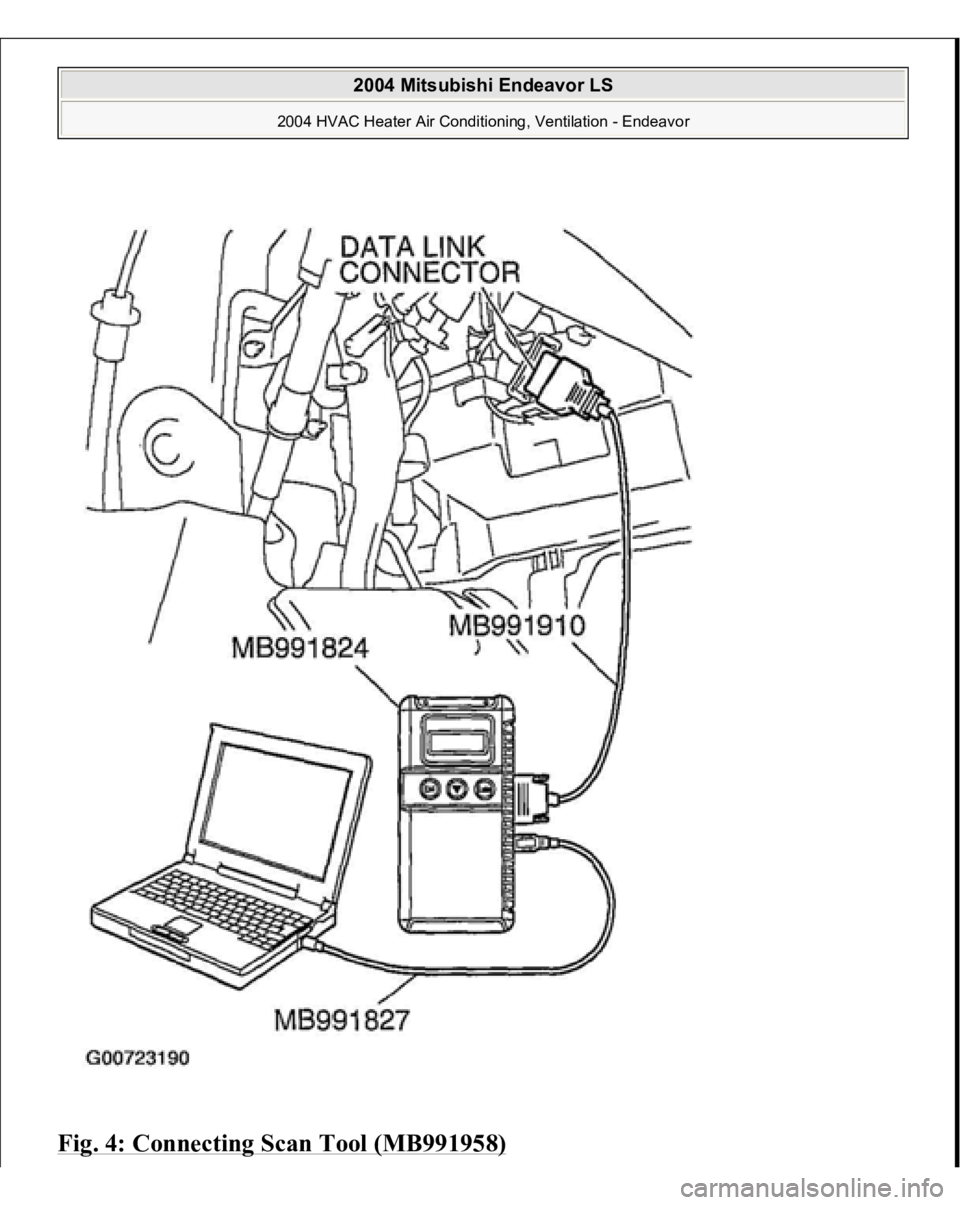
Fig. 4: Connecting Scan Tool (MB991958)
2004 Mitsubishi Endeavor LS
2004 HVAC Heater Air Conditioning, Ventilation - Endeavor
Page 2005 of 3870
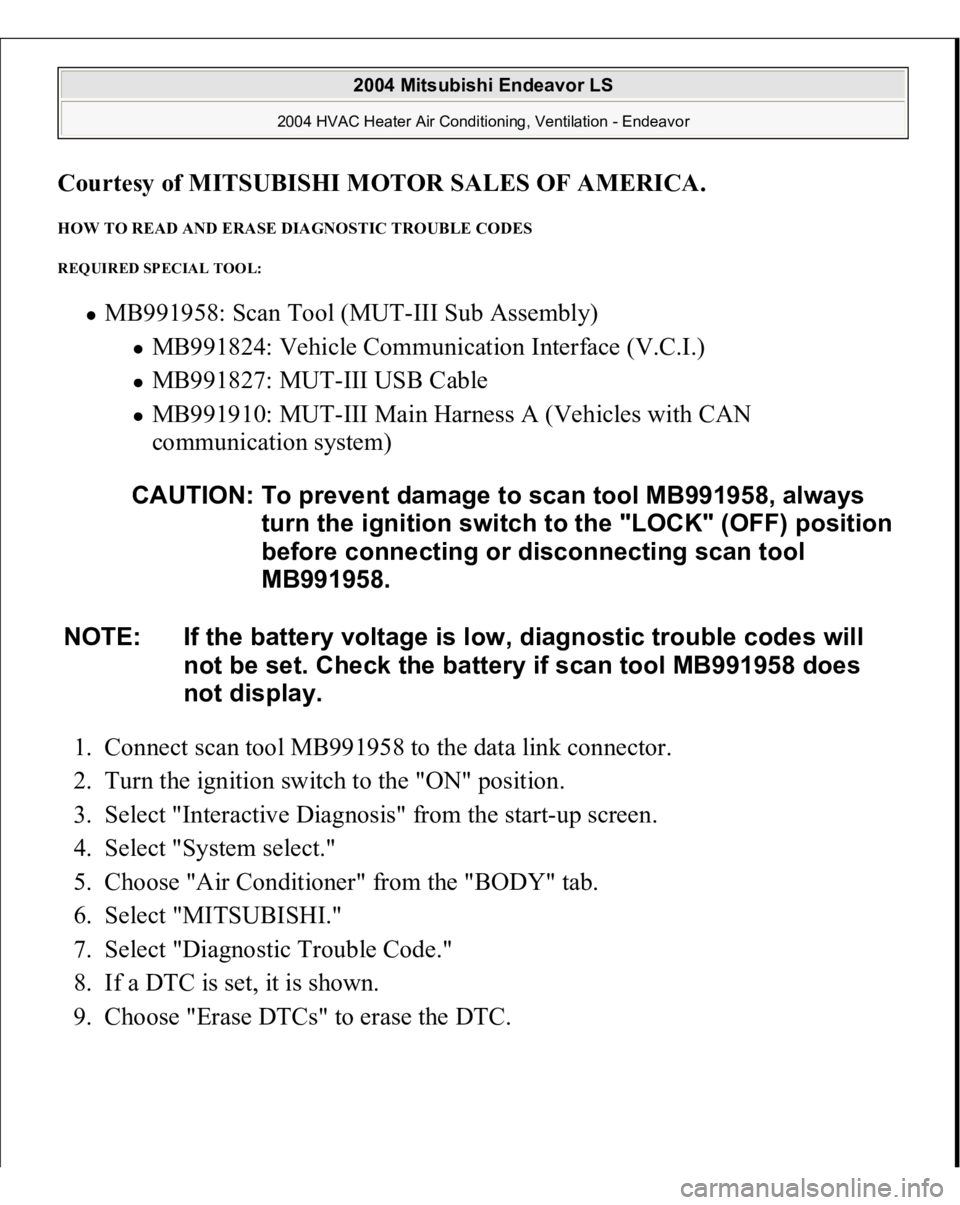
Courtesy of MITSUBISHI MOTOR SALES OF AMERICA
.
HOW TO READ AND ERASE DIAGNOSTIC TROUBLE CODES REQUIRED SPECIAL TOOL:
MB991958: Scan Tool (MUT-III Sub Assembly)
MB991824: Vehicle Communication Interface (V.C.I.) MB991827: MUT-III USB Cable MB991910: MUT-III Main Harness A (Vehicles with CAN
communication system)
1. Connect scan tool MB991958 to the data link connector.
2. Turn the ignition switch to the "ON" position.
3. Select "Interactive Diagnosis" from the start-up screen.
4. Select "System select."
5. Choose "Air Conditioner" from the "BODY" tab.
6. Select "MITSUBISHI."
7. Select "Diagnostic Trouble Code."
8. If a DTC is set, it is shown.
9. Choose "Erase DTCs" to erase the DTC. CAUTION: To prevent damage to scan tool MB991958, always
turn the ignition switch to the "LOCK" (OFF) position
before connecting or disconnecting scan tool
MB991958.
NOTE: If the battery voltage is low, diagnostic trouble codes will
not be set. Check the battery if scan tool MB991958 does
not display.
2004 Mitsubishi Endeavor LS
2004 HVAC Heater Air Conditioning, Ventilation - Endeavor